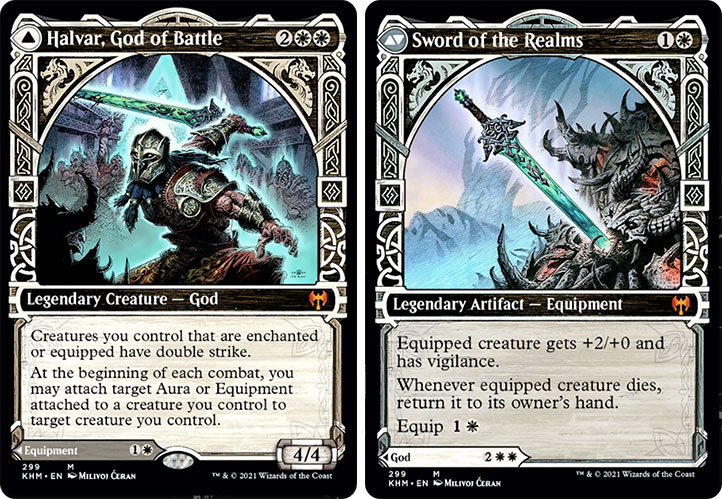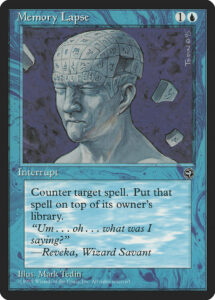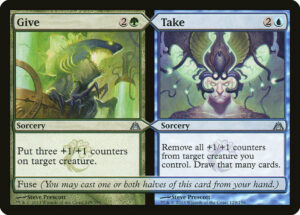Choice is an essential element of games. Choices are opportunities for players to learn, to leverage their understanding, and to demonstrate their aptitude. Remove all choice from a game (beyond whether to play) and you cease to have a game. Introduce too many choices, or too many difficult choices, and gameplay slows to a crawl while your audience dwindles.
Magic is obviously full of choices. It’s also full of mechanics like Cycling, Kicker, and Split Cards that present players with consistent options. Zendikar Rising introduced a new such mechanic with Modal Double-Faced Cards, offering players the option between a spell and land (or a choice of two lands). Kaldheim and Strixhaven will introduce different takes on MDFCs, where instead of always having a land on the backside of a card, there will be something else. We don’t know for certain yet, but we have our first piece of information with Halvar, God of Battle.
Halvar seems far less straightforward than what’s come before.
Easy Rules of Thumb
Magic’s existing choice mechanics have well-established heuristics. Kick spells when you have an abundance of mana, but most Kicker spells are perfectly acceptable without the bonus. Cycle expensive cards like Greater Sandwurm early in the game, cheap cards like Censor later on, and niche cards like Wilt when they lack utility. Play Zendikar Rising’s MDFC as lands early on and as spells later on. These rules of thumb won’t steer you correctly 100% of the time or with 100% of their cards; but they’re great, simple guidelines to get you playing without constantly pausing to consider every decision.
Halvar, God of Battle and Sword of the Realms don’t offer such a clean choice. They’re two different cards stapled together, each with powerful text boxes. It’s not immediately clear whether you want to build a deck around both sides of the card or focus on one. With Cycling cards and Zendikar Rising MDFCs, the cards are explicit about which option is the more desirable of the two—the front face—while the backside (or line of cycling text) is the support mode.
As of today, we only have a sample size of one Kaldheim MDFC to look at, and as a mythic it’s going to be more challenging to evaluate. But Kaldheim will almost certainly present players with harder choices than Zendikar Rising’s MDFCs ever did, thanks to having a choice between two spells. Even before we get to the choice of how to play with the cards, there’s the question of how easy the cards even are to remember.
Memory Taxation
Zendikar Rising did an excellent job of making its MDFCs easy to remember once you’d seen a few of them. They always have a land on the backside: it always taps for a single color, provides the same color of mana as its front side, and it always enters the battlefield tapped (Mythics and Pathways excepted). Learn these four rules and you never need to look at the backside of your MDFCs again. Having consistent back sides paired with inconsistent front sides served them well—imagine the mirror universe where you have a hand of Silundi Isle, Glasspool Shore, Beyeen Coast, and Jwari Ruins and are desperately trying to figure out which one casts Force Spike.
Halvar, God of Battle provides a a choice between two different Magic cards, making it more akin to the Split cards of Invasion than the MDFCs of Invasion. If every Kaldheim MDFC works similarly, then we’re looking at serious memory issues. Every time we’ve seen Split cards, Magic’s designers worked hard to distinguish them and minimized their use—Invasion block only had ten of them, one per color pair. Dissension had ten, one for each tricolor combination. Dragon’s Maze had fifteen, one per color pair and five that crossed Return to Ravnica guilds with Gatecrash guilds. Time Spiral had three. If Kaldheim MDFCs don’t have (effectively) duplicate back sides as Zendikar Rising MDFCs did, it’s hard to imagine there being more than a handful of them—split cards can already be challenging enough to remember with two simple effects you can see at the same time.
Peering Ahead
I’m excited to see how Wizards has addressed these issues in both Kaldheim and Strixhaven. Magic tends to be better when mechanics like Scry, Morph, Jump-start, Landcycling, and Monstrosity smooth out gameplay; and Kaldheim’s MDFCs will doubtlessly provide a new take on these beneficial choices. I doubt that they’ll present the always hard options that Fact or Fiction and Liliana of the Veil do—those are potent spices in extreme moderation and brain-melting in any higher concentrations. But designing MDFCs with distinct spells on both sides seems a whole lot harder than designing MDFCs with consistent lands on one side; and unlike space-crunched Split cards, there’s plenty of room and temptation to squeeze text on both sides.
My gut says that we will not only be seeing very simple effects on Kaldheim backsides, but we’ll be seeing effectively duplicate effects as we did in Zendikar Rising. We’ll be seeing far fewer than the 36 MDFCs it had, or we’ll be seeing less mechanical complexity in Kaldheim to compensate for its MDFCs. Choices are great things to have, but make them slightly harder to parse and you get formats like Shadowmoor draft (where hybrid mana made it really hard to figure out what colors you were in) or Dragon’s Maze sealed (where you’d need to make fifteen piles of colored cards). For now we wait, bid a very long overdue farewell to 2020, and get to be gifted by answers to our speculation soon in the new year.
Zachary Barash is a New York City-based game designer and the commissioner of Team Draft League. He designs for Kingdom Death: Monster, has a Game Design MFA from the NYU Game Center, and does freelance game design. When the stars align, he streams Magic (but the stars align way less often than he’d like).




